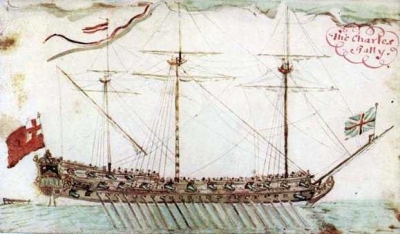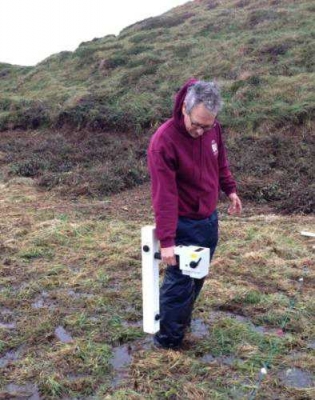
Pistil Cove, where the shipwreck victims possibly washed ashore. Photo M Hirst
Recent survey work has brought archaeologists closer to solving a 300 year old shipwreck mystery at Lizard Point.
In November 1721, 207 unfortunate sailors lost their lives in a ferocious storm when their military transport galley the Royal Anne hit rocks and sank off Lizard Point. Just three people survived that fateful night by clinging to wreckage. Among the dead was Lord Belhaven the newly appointed Governor of Barbados, who was leaving Britain’s shores to take up the posting in mysterious circumstances after the untimely death of his wife.
The Charles, a similar galley to the Royal Anne
The Royal Anne was designed by the Marquis of Carmarthen, and had been launched in 1709 as a small and speedy warship, designed to be equally at home under oar and sail so as not to be outmanoeuvred by pirates.
She had fulfilled a variety of military postings, including protecting Russian trade off Norway, combating the Rovers of Sallee, notorious Moroccan based pirates, and she was sent to cruise Scottish waters during the Jacobite rebellion.
The wreck of the Royal Anne was found close inshore near Lizard Point by divers in the 1970s, who first located two guns, but the wreck’s identity was only clinched in the 1990s by the discovery of some silver cutlery with the Belhaven family crest. The wreck site was protected in 1993 although the savage rocks and huge Atlantic swells mean that only a scatter of objects survive. Other finds have included coins, watch parts, copper bowls and cannon shot.
It is believed that the dead in 1721 were buried, as was customary at the time, in un-consecrated ground. The peaceful valley at Pistil just west of Lizard Point and 500m from the wreck site, has always been linked with this dreadful event, being one of the few places where the shore can be accessed.

The view seaward to Pistil Cove. Photo M Hirst
Local lore has it that the Lizard folk who went to bury the bodies could not complete this mammoth grizzly task within the day, but that when they returned next dawn, a pack of dogs had got their first and were tucking into a gruesome breakfast! Even to this day it is said that dogs cower when passing through the meadow, perhaps in shame at the actions of their ancestors. The story of Pistil Meadow fired the imaginations of later generations, with the likes of Daphne du Maurier and Wilkie Collins taking an interest in the tale.
 |
| Archaeologist at work |
Eager to investigate the truth behind these tales, the National Trust has teamed up with archaeologists from Bournemouth University, Maritime Archaeological Sea Trust (MAST) and The Cornwall and Isles of Scilly Maritime Archaeology Society (CISMAS) to survey Pistil meadow.
Recent geophys surveys using electromagnetic techniques, ground penetrating radar andearth resistivity have located a number of anomalies that could indicate mass graves. However, these do not seem to tally with writings in the 1850s that stated low irregular mounds chequered the surface of the field. The National Trust is working with MAST and Bournemouth University to explore the options for further stages of investigation.
Research so far has revealed a fascinating story about the Royal Anne and her crew, but it would be fantastic to be able to finally answer the question as to where her shipwreck victims were laid to rest – if Pistil is indeed the spot. It would be an extremely rare occurrence to find such a site.
The Trust is working in partnership on plans for a limited excavation Summer 2016, and the information gleaned will help inform management of the site, and may allow it to be afforded legal protection as a grave in future.
Published: Oct 2015
Author: Rachel Holder, Area Ranger, National Trust
